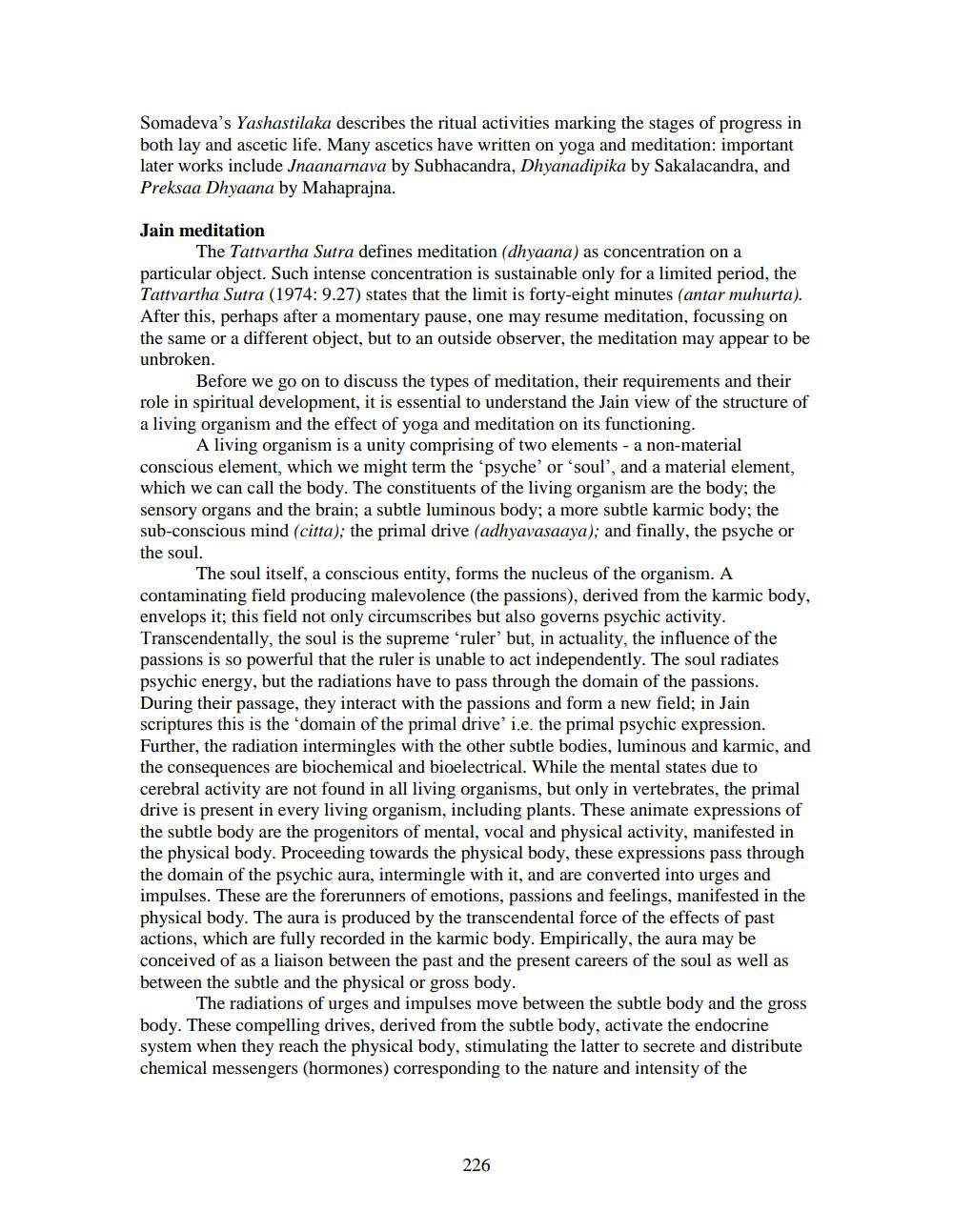________________
Somadeva's Yashastilaka describes the ritual activities marking the stages of progress in both lay and ascetic life. Many ascetics have written on yoga and meditation: important later works include Jnaanarnava by Subhacandra, Dhyanadipika by Sakalacandra, and Preksaa Dhyaana by Mahaprajna.
Jain meditation
The Tattvartha Sutra defines meditation (dhyaana) as concentration on a particular object. Such intense concentration is sustainable only for a limited period, the Tattvartha Sutra (1974: 9.27) states that the limit is forty-eight minutes (antar muhurta). After this, perhaps after a momentary pause, one may resume meditation, focussing on the same or a different object, but to an outside observer, the meditation may appear to be unbroken.
Before we go on to discuss the types of meditation, their requirements and their role in spiritual development, it is essential to understand the Jain view of the structure of a living organism and the effect of yoga and meditation on its functioning.
A living organism is a unity comprising of two elements - a non-material conscious element, which we might term the 'psyche' or 'soul', and a material element, which we can call the body. The constituents of the living organism are the body; the sensory organs and the brain; a subtle luminous body; a more subtle karmic body; the sub-conscious mind (citra); the primal drive (adhyavasaaya); and finally, the psyche or the soul.
The soul itself, a conscious entity, forms the nucleus of the organism. A contaminating field producing malevolence (the passions), derived from the karmic body, envelops it; this field not only circumscribes but also governs psychic activity. Transcendentally, the soul is the supreme 'ruler' but, in actuality, the influence of the passions is so powerful that the ruler is unable to act independently. The soul radiates psychic energy, but the radiations have to pass through the domain of the passions. During their passage, they interact with the passions and form a new field; in Jain scriptures this is the 'domain of the primal drive' i.e. the primal psychic expression. Further, the radiation intermingles with the other subtle bodies, luminous and karmic, and the consequences are biochemical and bioelectrical. While the mental states due to cerebral activity are not found in all living organisms, but only in vertebrates, the primal drive is present in every living organism, including plants. These animate expressions of the subtle body are the progenitors of mental, vocal and physical activity, manifested in the physical body. Proceeding towards the physical body, these expressions pass through the domain of the psychic aura, intermingle with it, and are converted into urges and impulses. These are the forerunners of emotions, passions and feelings, manifested in the physical body. The aura is produced by the transcendental force of the effects of past actions, which are fully recorded in the karmic body. Empirically, the aura may be conceived of as a liaison between the past and the present careers of the soul as well as between the subtle and the physical or gross body.
The radiations of urges and impulses move between the subtle body and the gross body. These compelling drives, derived from the subtle body, activate the endocrine system when they reach the physical body, stimulating the latter to secrete and distribute chemical messengers (hormones) corresponding to the nature and intensity of the
226




